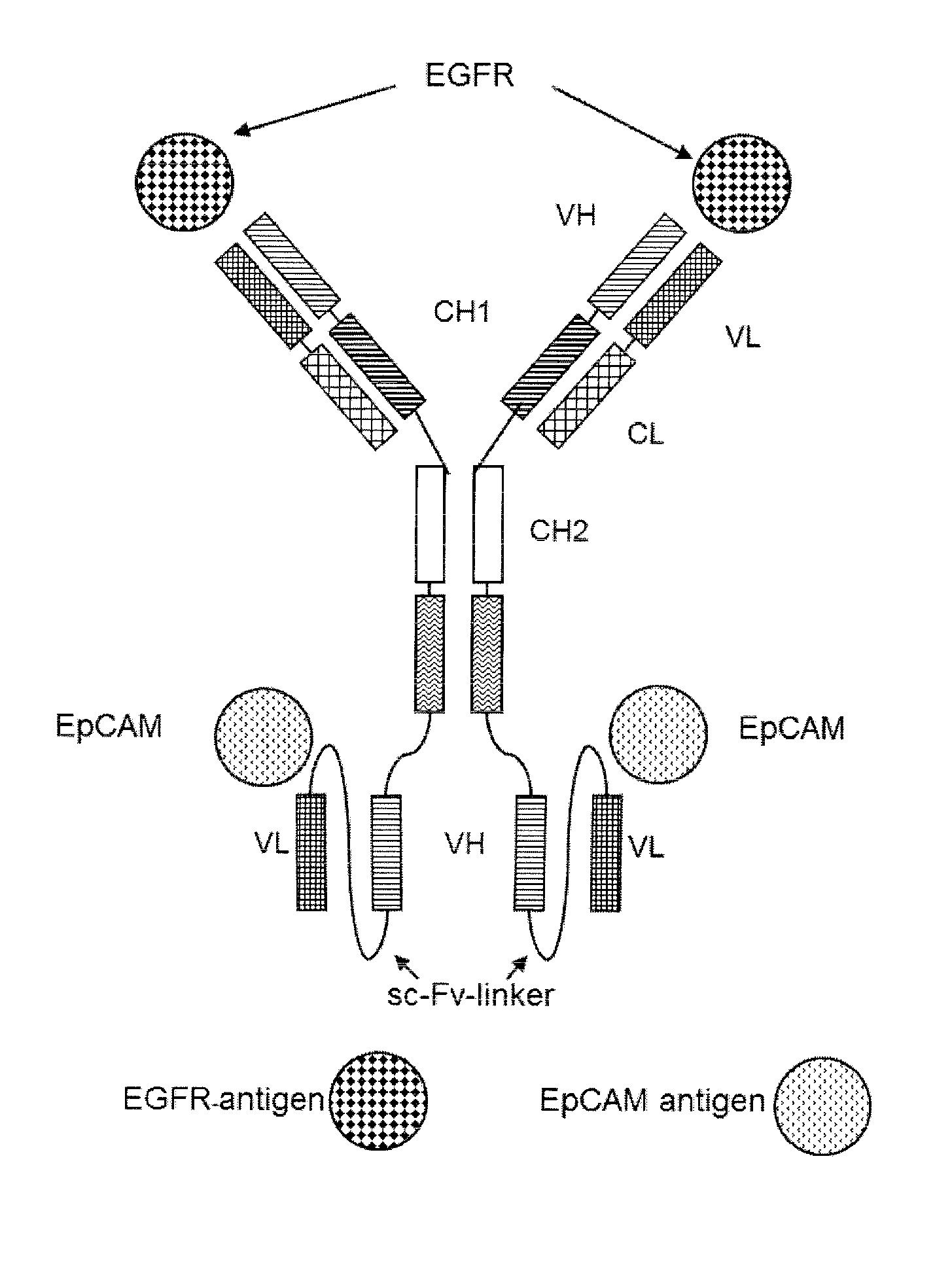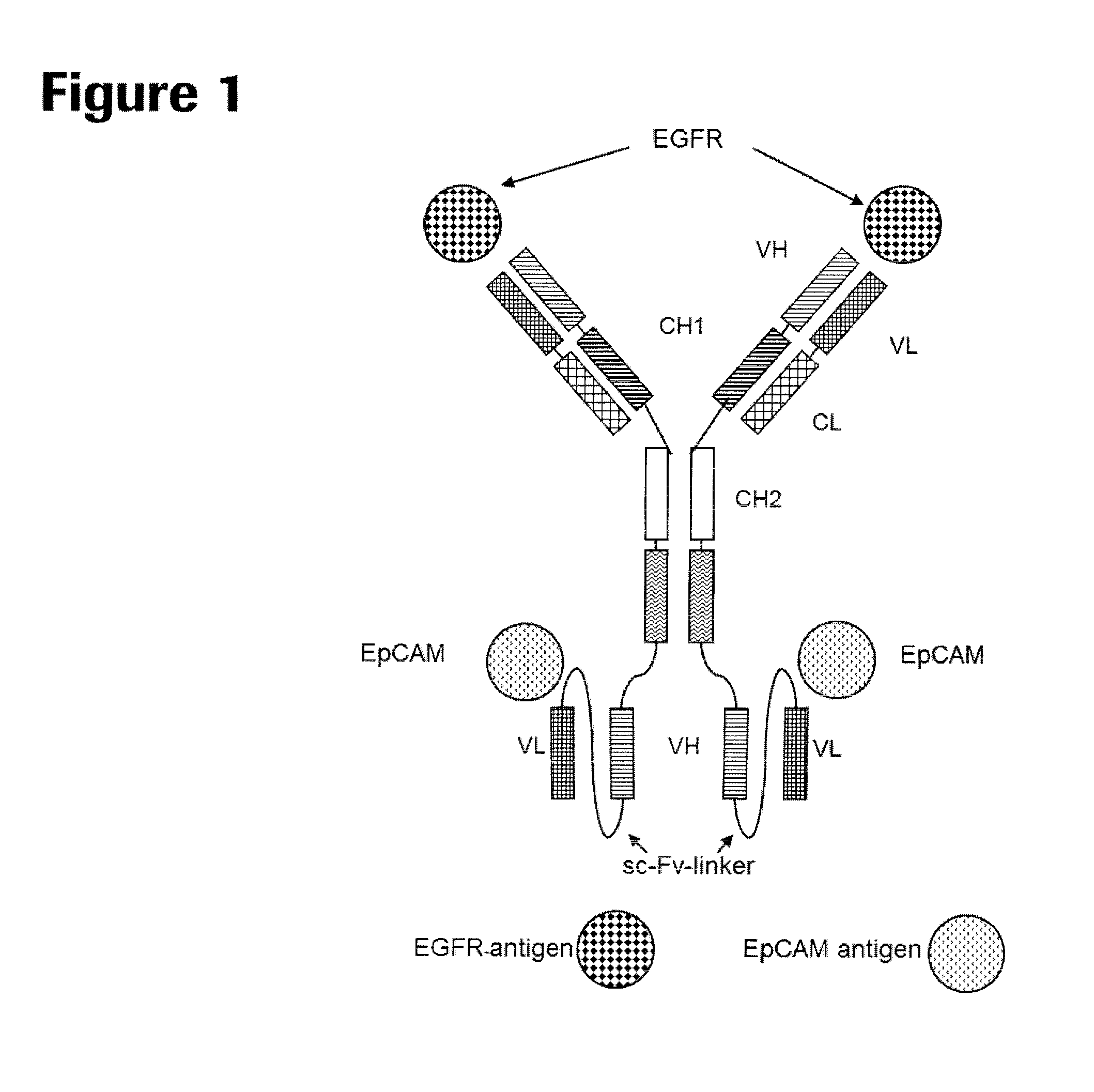Bispecific antibody molecules with antigen-transfected t-cells and their use in medicine
a technology of t-cells and specific antibodies, which is applied in the direction of antibody medical ingredients, fused cells, drug compositions, etc., can solve the problems of long half-life, possible use of antibody formats with a long half-life, and undesirable long-term effects
- Summary
- Abstract
- Description
- Claims
- Application Information
AI Technical Summary
Benefits of technology
Problems solved by technology
Method used
Image
Examples
example 1
Cloning and Expression of the Bispecific Antibody MAb225_scFv_G8.8 Recombinant DNA Techniques
[0216]Standard methods were used to manipulate DNA as described in Sambrook, J. et al., Molecular cloning: A laboratory manual; Cold Spring Harbor Laboratory Press, Cold Spring Harbor, N.Y., 1989. The molecular biological reagents were used according to the manufacturer's instructions.
DNA and Protein Sequence Analysis and Sequence Data Management
[0217]General information regarding the nucleotide sequences of human immunoglobulins light and heavy chains is given in: Kabat, E. A. et al., (1991) Sequences of Proteins of Immunological Interest, Fifth Ed., NIH Publication No 91-3242. Amino acids of antibody chains are numbered according to EU numbering (Edelman, G. M., et al., PNAS 63 (1969) 78-85; Kabat, E. A., et al., (1991) Sequences of Proteins of Immunological Interest, Fifth Ed., NIH Publication No 91-3242). The GCG's (Genetics Computer Group, Madison, Wis.) software package version 10.2 an...
example 2
Expression and Purification of the EpCAM Ectodomain Showing High Binding Affinity
[0245]2.1 Transient expression of immunoglobulin variants in human embryonic kidney 293 (HEK293) cells Recombinant immunoglobulin variants (MAB225, MAB225_scFv_G8.8 and G8.8) were expressed by transient transfection of human embryonic kidney 293-F cells using the FreeStyle™ 293 Expression System according to the manufacturer's instruction (Invitrogen, USA). Briefly, suspension FreeStyle™ 293-F cells were cultivated in FreeStyle™ 293 expression medium at 37° C. / 8% CO2. Cells were seeded in fresh medium at a density of 1×106 viable cells / ml the day before transfection. DNA_-293fectin™ complexes were prepared in Opti-MEM® I medium (Invitrogen, USA) using 665 μl of 293-Free™ Transfection Reagent (Novagen, EMD, USA) and 500 μg of total DNA (including the light chain plasmid DNA and the heavy chain plasmid DNA in a 1:1 molar ratio) for 500 ml final transfection volume. Antibody containing cell culture superna...
example 3
Transduction of CD8+ T-Cells and Cytotoxic Killing Assay
3.1 Cell Culture
[0253]Spleen was harvested from mice described below under item 32. Single cell suspension was obtained through mashing the spleen through a 40 μM cell strainer (BD Falcon, Germany). Strainer was washed 3 times with plain T-cell medium and cell pellet was freed from erythrocytes by erilysis solution (BD Pharmingen, Germany) for 90 seconds. Primary murine T-cells were maintained in T-cell medium composed of RPMI, 1% L-Glutamin, 1% Penicillin and Streptomycin, 1% Natrium Pyruvat, 1 mM HEPES (all PAA, Germany) and 10% FBS (Gibco, USA). T-cell line B3Z (Leisegang et al., J Mol Med (2008), 86(5), 573-583) was maintained in the same medium. Plat E packaging cell line (Cell Biolabs, Inc, USA (www.cellbiolabs.com)) was maintained in DMEM, 1% L-Glutamin, 1% Penicillin-Streptomycin (all PAA, Germany), 10 μg / ml Puromycin and 1 μg / ml Blasticidin (Sigma, Germany). The murine gastric cancer cell line was kindly provided by W....
PUM
| Property | Measurement | Unit |
|---|---|---|
| time | aaaaa | aaaaa |
| time | aaaaa | aaaaa |
| time | aaaaa | aaaaa |
Abstract
Description
Claims
Application Information
 Login to View More
Login to View More - R&D
- Intellectual Property
- Life Sciences
- Materials
- Tech Scout
- Unparalleled Data Quality
- Higher Quality Content
- 60% Fewer Hallucinations
Browse by: Latest US Patents, China's latest patents, Technical Efficacy Thesaurus, Application Domain, Technology Topic, Popular Technical Reports.
© 2025 PatSnap. All rights reserved.Legal|Privacy policy|Modern Slavery Act Transparency Statement|Sitemap|About US| Contact US: help@patsnap.com



